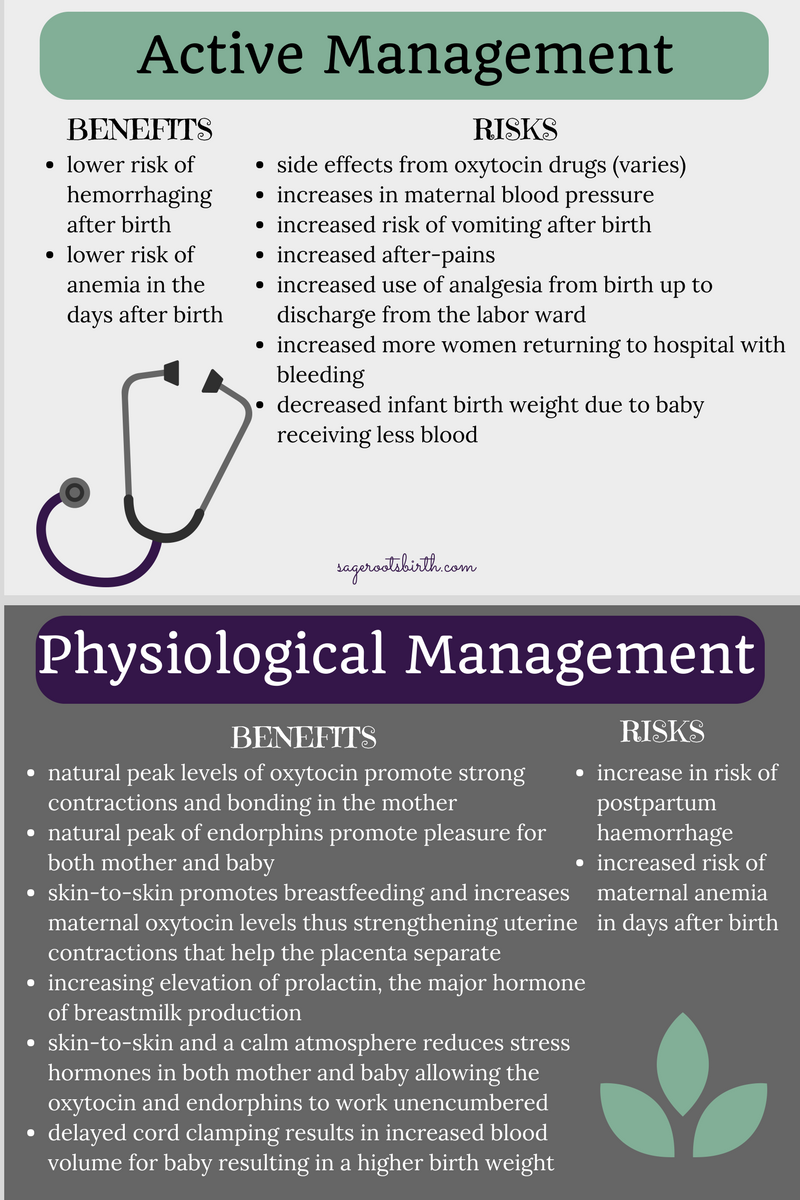|
Of the three stages of labor, the third one is the most often overlooked. Stage one, otherwise known as “labor,” can be intense and preparation is of course needed. The second stage, the pushing stage, might be an odd sensation and something difficult to describe to the first-time mother making it a big unknown needing a lot of research and understanding. The first two stages of birth get a lot of well-deserved attention. Yet, birth has a third stage, the placental delivery, worth paying close attention to as well. What kind of care you receive during the third stage has just as much impact on your experience, your health, and your baby’s health. Therefore, it is beneficial to be familiar with your choices and options. Active management of the third stage is what comes standard in most hospitals. If you are planning on giving birth in a hospital, these are the things you can both expect and discuss with your provider beforehand. Active management involves three components: 1.) a dose of an oxytocin drug (such as Pitocin) to stimulate stronger contractions and expel the placenta, 2.) clamping the umbilical cord soon after birth or before it stops pulsing, 3.) controlled cord traction in an effort to remove the placenta as quickly as possible. This method of care was introduced as part of an effort to reduce severe blood loss at birth (hemorrhage). Hemorrhaging shortly after birth is a major cause of women dying in low-income countries where women are more likely to be poorly nourished, anemic and have infectious diseases. However, active management has also become the norm in high-income countries where severe bleeding occurs much less often. The benefits to active management include a lower risk of hemorrhaging after birth and a lower risk of anemia in the days after birth in the mother. The risks include side effects from oxytocin drugs, increases in maternal blood pressure, increased risk of vomiting after birth, increased after-pains, increased use of analgesia from birth up to discharge from the labor ward, increased chance of needing to return to the hospital after discharge do to bleeding, decreased infant birth weight due to baby receiving less blood. Physiological, or as it’s sometimes called “expectant” or “natural,” management of the third stage is typically the care received at home births or in birth centers where intervention rates are much lower in general. You can expect and discuss the following with your care provider: 1.) no use of oxytocin drugs, 2.) nor any controlled cord traction as the placenta will detach and be expelled naturally, 3.) delayed cord clamping takes place where the cord is not cut until it stops pulsing and is limp and white or even later, 4.) undisturbed skin-to-skin for an hour after birth. Active management is indeed more “active” as it encourages promptness of the third stage, often resulting in the placenta being delivered within 15 minutes. The physiological method may take an hour or more, however, it recognizes that both mother and baby are making huge transitions during this time. The baby is adjusting to a completely new environment and the mother is shifting from pregnant to nonpregnant within moments. There are some measurable benefits to the “expectant” management such as: 1.) natural peak levels of oxytocin promote strong contractions and bonding in the mother, 2.) natural peak of endorphins promote pleasure for both mother and baby, 3.) skin-to-skin promotes breastfeeding and increases maternal oxytocin levels thus strengthening uterine contractions that help the placenta separate, 4.) increasing elevation of prolactin, the major hormone of breastmilk production, 5.) skin-to-skin and a clam atmosphere reduces stress hormones in both mother and baby allowing the oxytocin and endorphins to work unencumbered, 6.) delayed cord clamping results in increased blood volume for baby resulting in a higher birth weight. There are of course the increased risks of postpartum hemorrhage and the increased risk of maternal anemia in the days after birth when managing the third stage physiologically. There is a middle ground called “mixed management” which uses some, but not all, of the three components of active management. More and more hospitals are beginning to encourage skin-to-skin and/or delayed cord clamping for at least 90 seconds, for example, while keeping the other components of active management. Whatever birth setting you’ve chosen, I encourage you to talk to your care provider about their standard practices during the final stage of labor. Make sure you understand the benefits and risks to each, weighing them to decide what is best for you.
Sources: Begley, C. M., Gyte G.M. Devane, D. McGuire, W., & Weeks, A. (2015, March 2). Active versus expectant management for women in the third stage of labour [Abstract]. Cochrane Pregnancy and Childbirth Group, (3). Buckley, S. J. (2009). Gentle birth, gentle mothering: A doctor’s guide to natural childbirth and gentle early parenting choices. Berkeley: Celestial Arts.
0 Comments
Leave a Reply. |
LauraI'm the owner of Sage Roots. Woman, wife, mother, doula, writer, bookworm, hiker, gamer, and Christian. Categories
All
Archives
September 2022
|
Services |
Company |
|




